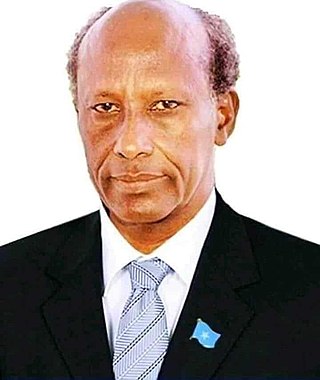
Mohamed Farrah Hasan Garad, popularly known as General Aidid or Aideed, was a Somali military officer and warlord.

Mohammed Siad Barre was a Somali military officer, politician and revolutionary who served as the third president of Somalia from 21 October 1969 to 26 January 1991.

The Somali Democratic Republic was a socialist state in Somalia that existed from 1969 to 1991.
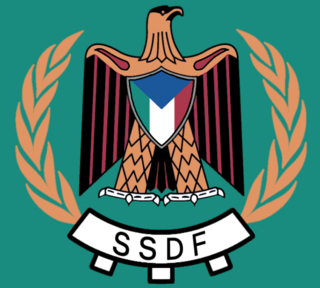
Somali Salvation Democratic Front (SSDF) (Somali: Jabhadda Diimuqraadiga Badbaadinta Soomaaliyeed), initially known as the Democratic Front for Salvation of Somalia, was a political and paramilitary umbrella organization in Somalia. Founded in 1978 by several army officers, it was the first of several opposition groups dedicated to ousting the authoritarian regime of Mohamed Siad Barre. With its power base mainly in the Majeerteen clan, SSDF played a significant role in the country's complex political landscape during the late 1970s and 2000s. And Succeeded by the establishment in 1998 of the autonomous Puntland state in northeastern Somalia.
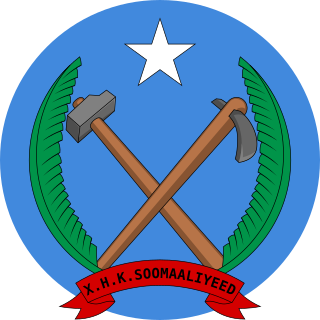
The Somali Revolutionary Socialist Party was the ruling party of the Somali Democratic Republic from 1976 to 1991.
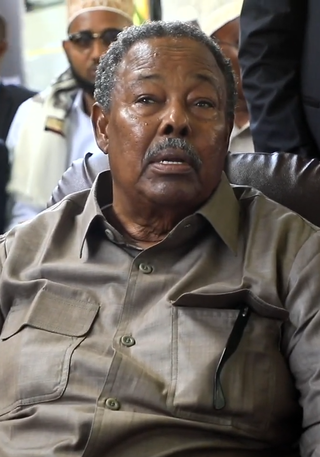
Ali Mahdi Muhammad was a Somali entrepreneur and politician. He served as President of Somalia from 26 January 1991 to 27 August 1993. The Cairo Agreement in December 1997 designated Ali Mahdi as president once again, a position he held until being succeeded by Abdiqasim Salad in the year 2000.
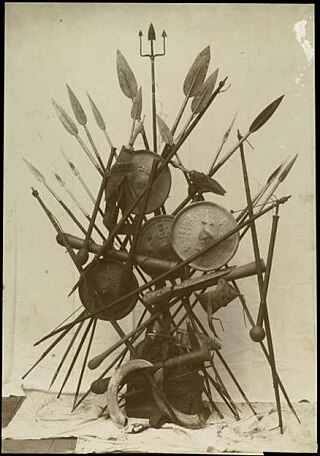
The Rahanweyn, also known as the Digil and Mirifle is a major Somali clan. It is one of the major Somali clans in the Horn of Africa, with a large territory in the densely populated fertile valleys of the Jubba and Shebelle rivers and the areas inbetween, which are mainly inhabited by settlers from the Digil and Mirifle lineages.
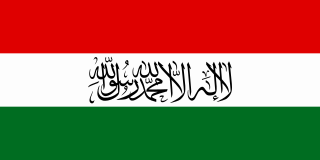
The Somali National Movement was one of the first and most important organized guerilla groups and Mujahideen groups that opposed the Siad Barre regime in the 1980s to the 1990s, as well as being the main anti-government faction during the Somaliland War of Independence. The organisation was founded in London, England, on April 6, 1981 by Hassan Isse Jama, Hassan Adan Wadadid, and Ahmed Mohamed Gulaid and other former Somali diplomats, who stated that initially the group's purpose was to overthrow the Siad Barre regime.
The Somali Rebellion was the start of the Somali Civil War that began in the 1970s and resulted in the collapse of the Somali Democratic Republic in 1991. The rebellion effectively began in 1978 following a failed coup d’état and President Siad Barre began using his special forces, the "Red Berets", to attack clan-based dissident groups opposed to his regime. Backed by Ethiopia, the two earliest rebel factions, the Somali Salvation Democratic Front (SSDF) and the Somali National Movement (SNM) began attacks during the against government forces during the early 1980s.

The National Security Service (NSS) was the primary intelligence agency of the Somali Democratic Republic from 1970 to 1990. The NSS was formed as the secret police under the government of Siad Barre in 1970, modelled after the KGB of the Soviet Union, and was formally dissolved in 1990 shortly before Barre's overthrow. In 2013, the Federal Government of Somalia re-established the NSS as the national intelligence service, renaming it the National Intelligence and Security Agency (NISA).
Over the course of the Somali Civil War, there have been many revolutionary movements and militia groups run by competing rebel leaders which have held de facto control over vast areas within Somalia.
The Hangash, an acronym standing for Defence Security Agency, was a notorious secret police unit of the Siad Barre regime in Somalia until his overthrow in 1991.
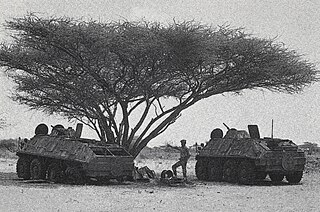
The 1982 Ethiopian–Somali Border War occurred from June to August 1982 when Ethiopia, sending a 10,000-man invasion force backed by warplanes and armored units, supported by thousands of Somali Salvation Democratic Front (SSDF) rebels, invaded central Somalia.

Parliamentary elections were held in Somalia on 26 March 1969. A total of 64 parties ran in the election, many of which had been formed shortly beforehand. The result was a victory for the Somali Youth League (SYL), which won 73 of the 123 seats. In total, 27 parties won seats, but immediately after the elections, most of the MPs for the smaller parties joined the Somali Youth League. The SYL held 109 seats by the end of May, in addition to being in a coalition with the Somali National Congress. This gave the SYL control of 120 of the 123 seats.

The Supreme Revolutionary Council was the governmental body that ruled Somalia from 1969 to 1976.

The Isaaq genocide, also known as the Hargeisa Holocaust, was the systematic, state-sponsored genocide of Isaaq civilians between 1987 and 1989 by the Somali Democratic Republic, under the dictatorship of Siad Barre, during the Somaliland War of Independence. The number of civilian deaths in this massacre is estimated to be between 50,000 and 100,000, according to various sources, whilst local reports estimate the total civilian deaths to be upwards of 200,000 Isaaq civilians. The genocide also included the levelling and complete destruction of the second and third largest cities in the Somali Republic, Hargeisa and Burao, respectively, and had caused up to 500,000 Somalis of the region, primarily of the Isaaq clan, to flee their land and cross the border to Hartasheikh in Ethiopia as refugees in what was described as "one of the fastest and largest forced movements of people recorded in Africa", which resulted in the creation of the world's largest refugee camp then (1988), with another 400,000 being displaced. The scale of destruction led to Hargeisa being known as the 'Dresden of Africa'. The killings happened during the Somali Civil War and have been referred to as a "forgotten genocide".

The 1969 Somali coup d'état was a bloodless military takeover of the Somali Republic on 21 October 1969, led by Somali National Army officers of the Supreme Revolutionary Council under General Siad Barre. After the assassination of President Abdirashid Shermarke in Las Anod, the Somali National Army under Barre's command stormed Mogadishu, seized key government buildings, and demanded the resignation of the country's leaders. The coup deposed acting President Sheikh Mukhtar Hussein and Prime Minister Mohammad Egal, ushering in a 21-year military rule under Barre and the establishment of an authoritarian government that lasted until 1991.
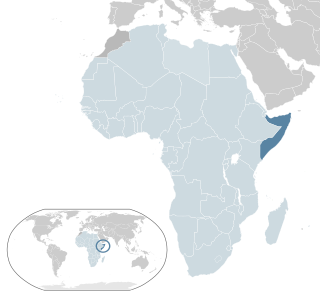
The 1978 Somali coup d'état attempt was a violent military coup attempt that took place in Somalia on 9 April 1978, against the regime of President Siad Barre. The United States Central Intelligence Agency estimated that the coup, led by Colonel Mohamed Osman Irro, involved around 24 officers, 2,000 soldiers, and 65 tanks. Following the failed coup, 17 alleged ringleaders, including Osman, were summarily executed by firing squad.

The Somaliland War of Independence was a rebellion waged by the Somali National Movement (SNM) against the ruling military junta in Somalia led by General Siad Barre lasting from its founding on 6 April 1981 and ended on 18 May 1991 when the SNM declared what was then northern Somalia independent as the Republic of Somaliland. The conflict served as the main theater of the larger Somali Rebellion that started in 1978. The conflict was in response to the harsh policies enacted by the Barre regime against the main clan family in Somaliland, the Isaaq, including a declaration of economic warfare on the clan-family. These harsh policies were put into effect shortly after the conclusion of the disastrous Ogaden War in 1978.
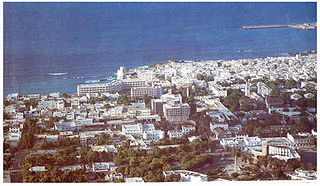
The Mogadishu riots of July 1989 were a series of violent events that took place in the capital city of Somalia on 14 and 15 July 1989. A significant event in modern Somali history, the riot and killings that followed were the first serious violence Mogadishu had seen and preluded the approaching Somali Civil War. The event was sparked by the assassination of Roman Catholic Bishop of Mogadishu Salvatore Colombo and the subsequent arrest of several Muslim religious leaders by the Barre regime.














